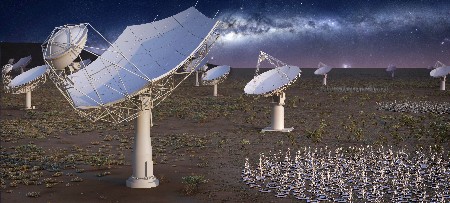by Larry
October, 2017What the Hey Is the SKA?Besides humans wanting to head for Mars or build a colony on the Moon, pursuits perhaps a bit far-fetched in view of problems we still have on Earth, there is now in the works an intriguing plan to build the world's largest radio telescope, so big it will require multiple countries and at least a couple continents to pull it off. Called the Square Kilometer Array (SKA), this project is set to commence next year and due to be completed in 2030. This single vast array would be a synchronized signal area involving hundreds or thousands of antennae in South Africa and Australia.
The hope is that such a large, sensitive, efficient collector of astronomical info will be able to shed light on numerous current puzzles of astronomy and physics, such as about relativity, black holes, the origin of the universe, galaxies, dark matter, and dark energy. Perhaps some of the secrets revealed will help scientists achieve what has been long sought but till now elusive, a theory of everything, that finally unites the laws of the very small (quantum mechanics forces) realms and the laws of the very large (gravity forces) space-time realm which we experience here and observe in outer space. For those eager to see the conclusion of the ambitious SKA project, it will fortunately not be necessary to wait another 11-12 years before its fruits begin to be available. The first substantial phase of development should be providing data by 2020. Already, the Australian Square Kilometer Array Pathfinder (ASKAP) has been in use and providing valuable new information, such as about mysterious and peculiar radio signals that only occur intermittently and with so far no understood origin. Due to the enormous costs and complexities involved, the SKA is scheduled to be made operational in two primary parts. The second will be able to take into account new scientific, engineering, computing, data filtering, and even geopolitical realities prevailing closer to the final completion date. Just as was true for the ill-fated TX CERN-like project, which never got the funding for completion, there is no guarantee that SKA will become a reality. If it does not, the solutions to a variety of enigmas of astrophysics may have to wait for yet a few more generations. |
